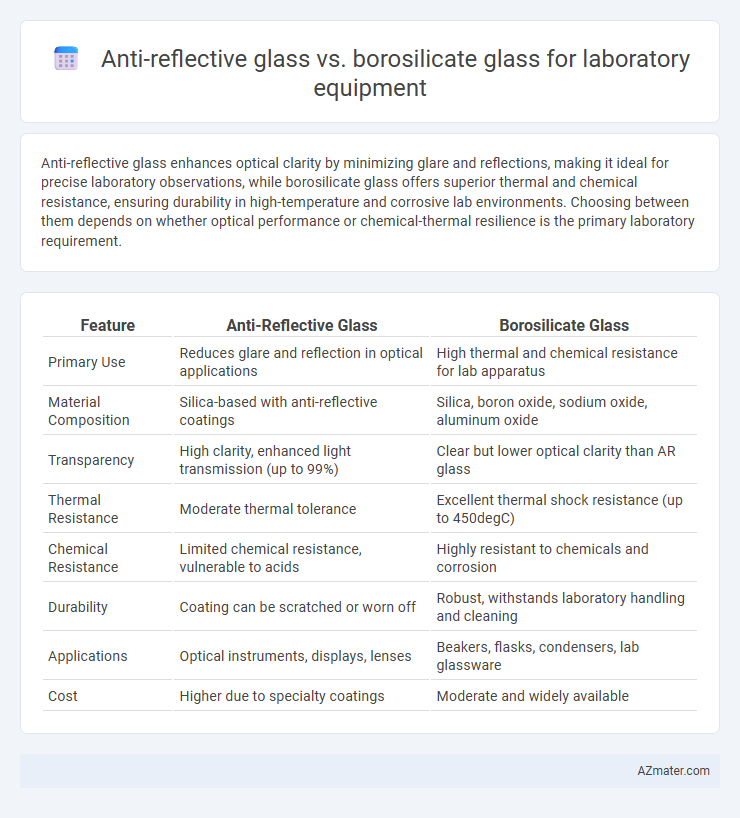Anti-reflective glass enhances optical clarity by minimizing glare and reflections, making it ideal for precise laboratory observations, while borosilicate glass offers superior thermal and chemical resistance, ensuring durability in high-temperature and corrosive lab environments. Choosing between them depends on whether optical performance or chemical-thermal resilience is the primary laboratory requirement.
Table of Comparison
| Feature | Anti-Reflective Glass | Borosilicate Glass |
|---|---|---|
| Primary Use | Reduces glare and reflection in optical applications | High thermal and chemical resistance for lab apparatus |
| Material Composition | Silica-based with anti-reflective coatings | Silica, boron oxide, sodium oxide, aluminum oxide |
| Transparency | High clarity, enhanced light transmission (up to 99%) | Clear but lower optical clarity than AR glass |
| Thermal Resistance | Moderate thermal tolerance | Excellent thermal shock resistance (up to 450degC) |
| Chemical Resistance | Limited chemical resistance, vulnerable to acids | Highly resistant to chemicals and corrosion |
| Durability | Coating can be scratched or worn off | Robust, withstands laboratory handling and cleaning |
| Applications | Optical instruments, displays, lenses | Beakers, flasks, condensers, lab glassware |
| Cost | Higher due to specialty coatings | Moderate and widely available |
Introduction to Laboratory Glass Types
Anti-reflective glass and borosilicate glass serve distinct roles in laboratory equipment due to their optical and thermal properties. Borosilicate glass is renowned for its exceptional thermal resistance and chemical durability, making it ideal for heating, mixing, and storing reactive substances. Anti-reflective glass enhances visibility and accuracy by reducing glare and reflections in optical instruments and measurement devices.
What is Anti-Reflective Glass?
Anti-reflective glass is specially coated to minimize light reflection and maximize light transmission, enhancing visibility and precision in laboratory experiments. This glass type reduces glare and ghost images caused by reflections, making it ideal for optical instruments and sensitive measurement devices. In comparison to borosilicate glass, known for thermal and chemical resistance, anti-reflective glass excels in performance where clear, unobstructed viewing is critical.
What is Borosilicate Glass?
Borosilicate glass, known for its exceptional thermal resistance and chemical durability, is widely used in laboratory equipment to withstand high temperatures and corrosive substances. Unlike standard glass, borosilicate contains boron trioxide, which reduces thermal expansion and enhances resistance to thermal shock, making it ideal for precise scientific applications. Anti-reflective glass, on the other hand, minimizes light reflection for improved visibility but lacks the thermal and chemical resilience characteristic of borosilicate glass in lab environments.
Optical Clarity: Anti-Reflective vs. Borosilicate Glass
Anti-reflective glass offers superior optical clarity by minimizing surface reflections and maximizing light transmission, which is essential for precise visual observations and accurate measurements in laboratory settings. Borosilicate glass, while chemically resistant and thermally stable, typically exhibits higher reflectance and lower light transmission compared to anti-reflective glass. Choosing anti-reflective glass enhances image clarity and reduces optical distortions, making it ideal for applications requiring high optical fidelity.
Chemical Resistance Comparison
Anti-reflective glass offers moderate chemical resistance suitable for general laboratory use but may degrade when exposed to strong acids or bases over time. Borosilicate glass exhibits superior chemical resistance, with excellent durability against a wide range of corrosive chemicals, making it ideal for aggressive chemical environments. Laboratories requiring robust chemical stability typically prefer borosilicate glass to prevent contamination and maintain equipment integrity.
Thermal Stability: Performance Under Heat
Anti-reflective glass offers moderate thermal stability suitable for routine laboratory applications, maintaining clarity under typical temperature fluctuations up to around 300degC. Borosilicate glass excels in thermal performance with a low coefficient of thermal expansion, allowing it to withstand rapid temperature changes and high heat exposure up to 500degC without cracking. The superior thermal resilience of borosilicate glass makes it ideal for high-heat laboratory processes such as heating and cooling cycles in chemical experiments.
Durability and Scratch Resistance
Anti-reflective glass used in laboratory equipment offers superior scratch resistance due to specialized coatings that enhance surface hardness and durability under frequent handling and cleaning. Borosilicate glass, known for its thermal and chemical resistance, provides strong durability against thermal shock but is more prone to surface scratches compared to anti-reflective glass. Laboratories requiring prolonged clarity and minimal maintenance often prefer anti-reflective glass for its balance of durability and reduced light reflection, while borosilicate glass remains ideal for experiments involving high temperature variations.
Cost and Availability Analysis
Anti-reflective glass offers superior light transmission and reduced glare, making it ideal for precise optical measurements but comes at a higher cost due to specialized coatings and limited suppliers. Borosilicate glass is widely available, cost-effective, and known for its high thermal and chemical resistance, which makes it a preferred choice for general laboratory equipment. The affordability and broad availability of borosilicate glass make it more accessible for laboratory use, while anti-reflective glass remains a premium option for specific optical applications.
Typical Applications in Laboratory Settings
Anti-reflective glass is commonly used in laboratory optical instruments such as microscopes, spectrophotometers, and optical sensors to enhance light transmission and reduce glare, improving measurement accuracy. Borosilicate glass is favored for its thermal resistance and chemical durability in applications like reaction vessels, laboratory glassware, and high-temperature experiments. Both materials are essential in laboratory settings but serve distinct roles based on optical clarity and thermal or chemical resilience.
Choosing the Right Glass for Your Laboratory Equipment
Anti-reflective glass offers superior light transmission and reduces glare, making it ideal for optical instruments and precise measurements in laboratories. Borosilicate glass provides excellent thermal and chemical resistance, ensuring durability under high temperature and corrosive conditions commonly encountered in lab experiments. Choosing the right glass depends on whether optical clarity or robust chemical and thermal stability is the primary requirement for your laboratory equipment.

Infographic: Anti-reflective glass vs Borosilicate glass for Laboratory equipment
 azmater.com
azmater.com